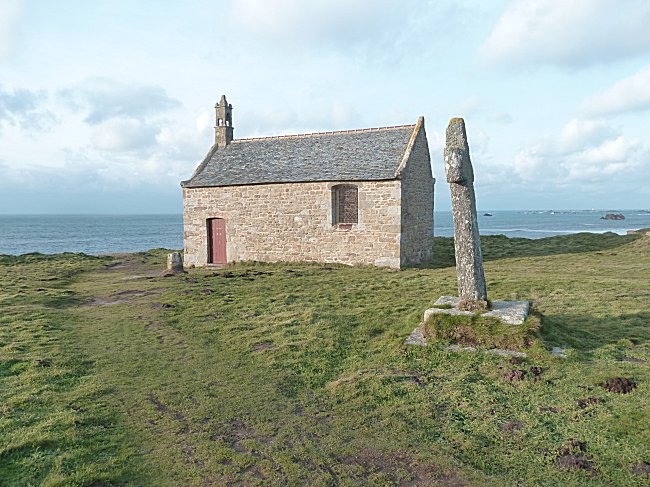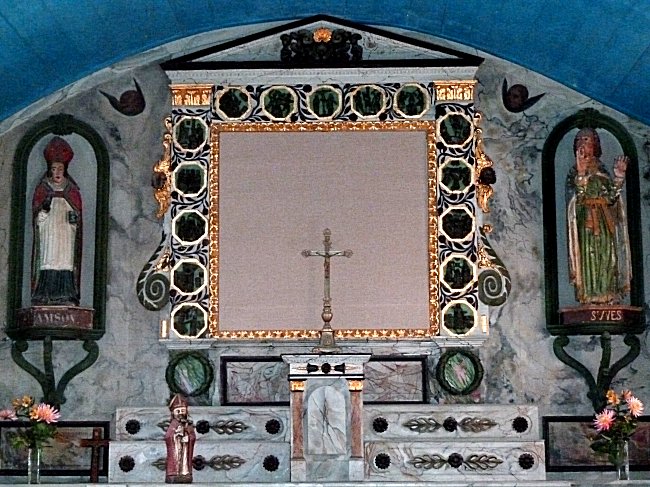
GPS : 48°32'56.5 N 4°44'06.6 W

Access :
Leave St-Renan by the Ploudalmézeau road (D68) and continue straight to the sea. Then turn right on the D27.
At a crossroads located 1.5 km further, turn left onto the D137 signposted "KERSAINT par la route touristique". Along 3 km then the beautiful coastline of Landunvez.
Park near the chapel, which is open daily from 10am to 6pm.

This small isolated chapel on the moor a few steps from a beautiful coast attracts many visitors. But it is not alone : a Gallic stele stands not far from the entrance and a fountain, visible along the coastal path, attest to the age of a cult at this site. Besides the spring water is still supposed to cure rheumatism and eye diseases.


This heptagonal stele from the Iron Age was reused as a cross support. One will notice that it carries an inscription engraved on one of the sides : TP ST GONVEL 1757. |

The water from the spring is collected by a fountain just before it flows into the sea. It is probable that it was Christianized by the presence of a cross long before the chapel was built. |
This chapel, built in 1785, was able to replace an older one. It was traditionally the goal of a Pardon of the Sea.
Restoration work :
The altarpiece once featured an oil painting, now replaced by a work by the painter Augustin Frison-Roche. Its woodwork, currently being restored, should soon be back in place.

The altarpiece before restoration work.
The old paint had been replaced by linen cloth.



Augustin Frison-Roche: Mary, protector and the Iroise Sea
Two polychrome statues dominate the altar. On the left, Saint Samson is wearing the episcopal mitre.

Among all the numerous monks who came from the British Isles in the VIth century to evangelize Brittany, Saint Samson is one of the few who are well attested by history since he signed the acts of the Council of Paris around 555.1
Originally from Wales, and a pupil of Saint Ildut who gave his name to Lanildut, he is said to have landed at Plougasnou, in the north of Finistère department, where the foundation of the Lanmeur monastery is attributed to him. He had been ordained bishop, without any bishopric, before coming to the continent. Appointed Bishop of Dol by King Childebert 1st, he died there around the year 565. Its influence throughout Brittany was such that many localities or Breton religious buildings bear his name. It's not impossible that he came to see his friend Ildut in the Iroise Country.
Two other statues attract the eye in this chapel.

On the left wall, Saint Isidore, the modest Spanish ploughman, represents a hard-working and very pious peasant model. |

To the right of the altar, Saint Yves is dressed as a magistrate. His gaze directed towards the litigants shows them his listening while with his raised hands, he indicates his impartiality 2 during his judgments. |
We will also take a look at the modern stained-glass windows dating from 1993. On the left, Saint Anne, the Virgin's mother, with her Daughter. On the right Saint Samson, whose bishop's crook can be seen, heals a sick man.

|

|
In short, a small chapel, modest and full of charm, situated in a wild and grandiose environment that gives it all the qualities of a real postcard subject.

***
READ MORE
Do not miss to visit the site of
the Association for the Safeguarding of the Landunvez Chapels
-1- Gildas Bernier : Les chrétientés bretonnes continentales depuis les origines jusqu'au IXe siècle, Rennes 1982, p 63.
-2- See also about Saint Yves our page dedicated to the church St-Tugdual de Trébabu :
here




